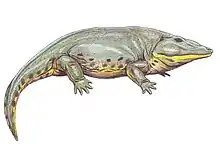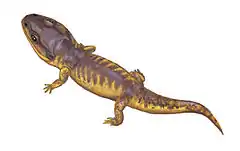Georgenthalia
Georgenthalia is an extinct genus of dissorophoid temnospondyl from the Lower Permian. It is an amphibamid which lived in what is now the Thuringian Forest of central Germany. It is known from the holotype MNG 11135, a small, complete skull. It was found in the Bromacker locality of the Tambach Formation. It was first named by Jason S. Anderson, Amy C. Henrici, Stuart S. Sumida, Thomas Martens and David S. Berman in 2008 and the type species is Georgenthalia clavinasica.[1]
| Georgenthalia Temporal range: | |
|---|---|
 | |
| Life restoration | |
| Scientific classification | |
| Domain: | Eukaryota |
| Kingdom: | Animalia |
| Phylum: | Chordata |
| Class: | Amphibia |
| Order: | †Temnospondyli |
| Suborder: | †Euskelia |
| Superfamily: | †Dissorophoidea |
| Clade: | †Amphibamiformes |
| Genus: | †Georgenthalia Anderson et al., 2008 |
| Species | |
References
- Jason S. Anderson; Amy C. Henrici; Stuart S. Sumida; Thomas Martens; David S. Berman (2008). "Georgenthalia clavinasica, A New Genus and Species of Dissorophoid Temnospondyl from the Early Permian of Germany, and the Relationships of the Family Amphibamidae". Journal of Vertebrate Paleontology. 28 (1): 61–75. doi:10.1671/0272-4634(2008)28[61:GCANGA]2.0.CO;2.
- Fröbisch, N.B.; Reisz, R.R. (2008). "A new Lower Permian amphibamid (Dissorophoidea, Temnospondyli) from the fissure fill deposits near Richards Spur, Oklahoma". Journal of Vertebrate Paleontology. 28 (4): 1015–1030. doi:10.1671/0272-4634-28.4.1015. S2CID 128698929.
This article is issued from Wikipedia. The text is licensed under Creative Commons - Attribution - Sharealike. Additional terms may apply for the media files.













